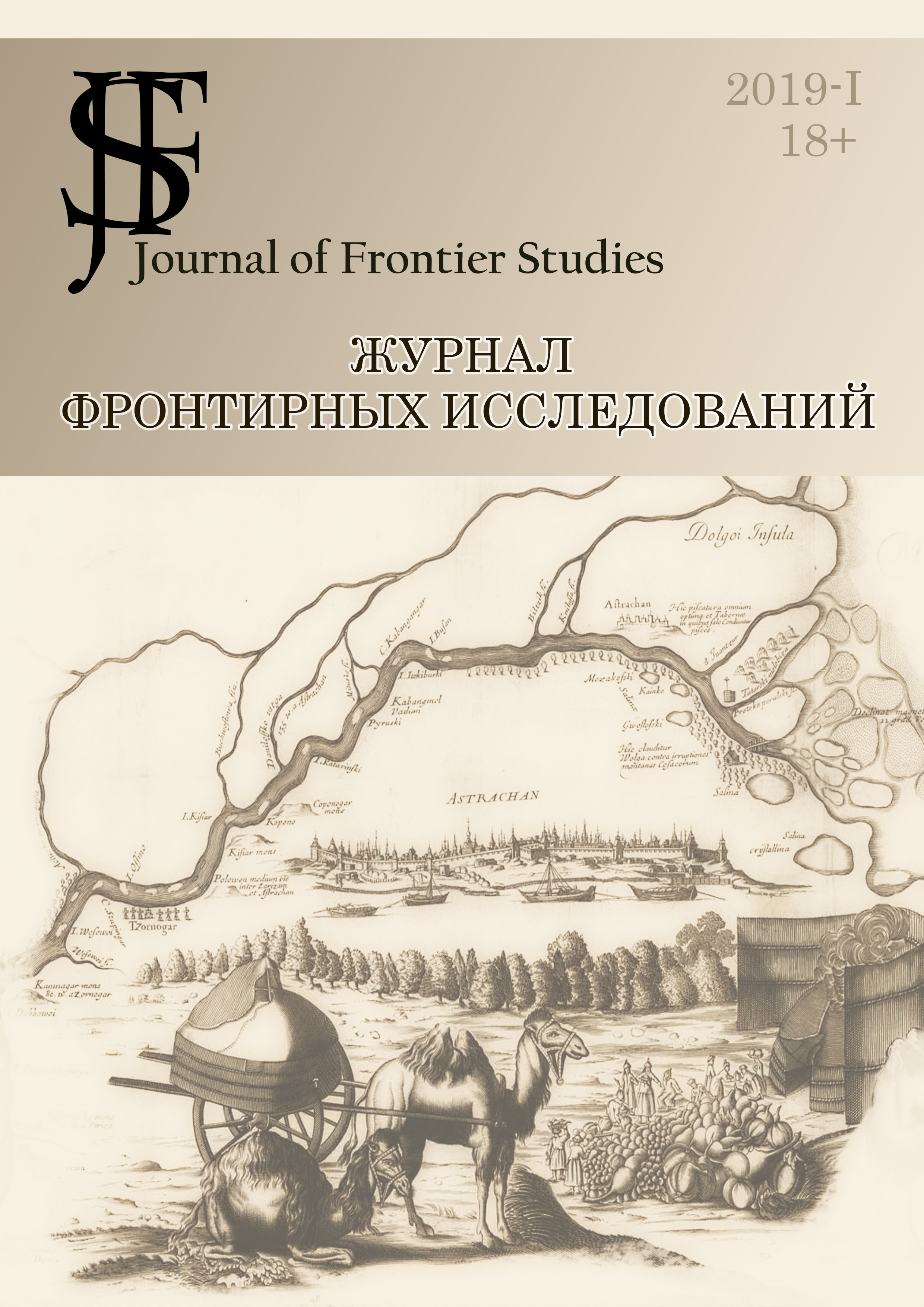Abstract
The article deals with the struggle for power in Mordovian autonomy in the late 1980s – early 1990s, which took place between the old Communist local leaders and democratic organizations that emerged during «Perestroika». After the abolition in the Constitution of the USSR of the article proclaiming the leading role of the Communist party in life of the country, local leaders strived to gain a foothold in the legislative bodies, first in the Supreme Council of the Republic and then in the State Assembly.
The article is based on archival documents from the funds of the regional Committee of the CPSU, the Supreme Council of Mordovia, and memories of key figures of this historical process, namely, the former Chairman of the Supreme Council and President of Mordovia.
The media materials covering events of this political struggle are widely used. They depict the movement towards power of the Head of the "Democratic initiative", the methods of activities of his supporters, the reasons of the fall of his authority and the loss of public support, as a result of which former Communist leaders regained their positions in the legislative and executive structures of the Republic. In turn, however, their desire to stay on the "platform of socialism" weakened these structures letting the former Communist leaders of the district level to obtain power again. Those refused to revive the Communist system «in the Republic» and quickly moved to the ideology and practice of market relations. In this struggle the Mordovian national public organizations with which the so-called «Mordovians» acquired unexpectedly great importance, democratic leaders were unable to achieve cooperation due to the lack of management experience and misunderstanding of the role of interethnic, often latent relations in a multinational Republic.
References
(1991). Российская газета(316), стр. 1.
(1993a). Мордовия(1), стр. 2.
(1993a). Советская Мордовия(61), стр. 1.
(1993b). Мордовия(16), стр. 2.
(1993b). Советская Мордовия(102), стр. 1.
Абрамов, В. К. (2010). Мордовское национальное движение. Изд. 2. Испр. и доп. Саранск.
Абрамов, В. К. (2018). Воспоминания Н. В. Бирюкова, записанные автором.
Абрамов, В. К. (2018). Воспоминания В. Д. Гуслянникова, записанные автором.
Абрамов, В. К. (2018). Воспоминания С.Ф. Сорокина, записанные автором.
Доленко, Д. (1991). Триумфальное шествие президентской власти. Саранские вести(178), стр. 2.
Конституционный суд Мордовии поставил последнюю точку: пост президента упразднен. (1993). Мордовия(47), стр. 3-8.
Лезина, Е. П. (2014). Президентская республика в Мордовии (конец 1991 - первая половина 1993 года). Социально-политические науки(4), 22-26.
Майоров, И. (1994). Напраслина. Советская Мордовия(9), стр. 1.
Огрина, Г. В. (2013). Мордовия в годы перестройки(1985–1991): власть и общество. PhD thesis. Саранск.
Полутин, С. В. (2000). Республика Мордовия. В К. Мацузато (Ред.), Регионы России: хроника и руководители (стр. 151-266). Саппоро.
Постановление Верховного Совета Мордовской ССР «О социально-экономическом положении республики и программе (основных направлениях) деятельности правительства Мордовской ССР на период стабилизации экономики. (1993). Мордовия(1), стр. 2.
Сергеенков, В. Н. (2012). Мордовская петля. Retrieved from https://sergeenkov-v.livejournal.com/5289.html
Телеграмма Верховному Совету Республики Мордовия Президента Российской Федерации Б.Н. Ельцина. (1993). Советская Мордовия(65), стр. 1.
Указ Президента Мордовской ССР. (1993). Советская Мордовия(64), стр. 1.
Указ Президента Российской Федерации № 430 от 08. 04. (1993). Retrieved from https://www.lawmix.ru/zakonodatelstvo/99078
ЦГА РМ. (Оп. 1. Д. 13.). Ф. 6206-П.
ЦГА РМ. (Оп. 10. Д. 1156.). Ф. 269-П.
Центральный государственный архив Республики Мордовия (ЦГА РМ). (Оп. 10. Д. 1154.). Ф. Р-234.
References
(1991). Rossiyskaya Gazeta (316), p. 1.
(1993a). Mordovia (1), p. 2.
(1993a). Soviet Mordovia (61), p. 1.
(1993b). Mordovia (16), p. 2.
(1993b). Soviet Mordovia (102), p. 1.
Abramov, V. K. (2010). Mordovian national movement. Ed. 2. Corr. and add. Saransk.
Abramov, V.K. (2018). Memories N. V. Biryukov, recorded by the author.
Abramov, V.K. (2018). Memories V. D. Guslyannikov, recorded by the author.
Abramov, V.K. (2018). Memoirs S.F. Sorokin, recorded by the author.
Dolenko, D. (1991). Triumphal procession of presidential power. Saransk news (178), p. 2.
The Constitutional Court of Mordovia has put the last point: the presidency has been abolished. (1993). Mordovia (47), pp. 3-8.
Lezina, E.P. (2014). Presidential republic in Mordovia (late 1991 - first half of 1993). Socio-political sciences (4), 22-26.
Mayorov, I. (1994). Napraslin. Soviet Mordovia (9), p. 1.
Ogrina, G. V. (2013). Mordovia in the years of perestroika (1985–1991): power and society. PhD thesis. Saransk.
Polutin, S.V. (2000). The Republic of Mordovia. In C. Macuzato (Ed.), Regions of Russia: Chronicles and Managers (pp. 151-266). Sapporo.
Resolution of the Supreme Council of the Mordovian SSR "On the socio-economic situation of the republic and the program (main directions) of the government of the Mordovian SSR for the period of stabilization of the economy." (1993). Mordovia (1), p. 2.
Sergeenkov, V.N. (2012). Mordovian loop. Retrieved from https://sergeenkov-v.livejournal.com/5289.html
Telegram to the Supreme Council of the Republic of Mordovia of the President of the Russian Federation B.N. Yeltsin. (1993). Soviet Mordovia (65), p. 1.
Decree of the President of the Mordovian SSR. (1993). Soviet Mordovia (64), p. 1.
Presidential Decree number 430 from 08. 04. (1993). Retrieved from https://www.lawmix.ru/zakonodatelstvo/99078
Central State Archive of the Republic of Mordovia (CSA RM). (Ref. 1. D. 13.). F. 6206-P.
Central State Archive of the Republic of Mordovia (CSA RM). (Ref. 10. D. 1156.). F. 269-P.
Central State Archive of the Republic of Mordovia (CSA RM). (Ref. 10. D. 1154.). F. P-234.

This work is licensed under a Creative Commons Attribution-NonCommercial-NoDerivatives 4.0 International License.

